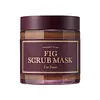What's inside
What's inside
 Key Ingredients
Key Ingredients

 Benefits
Benefits

 Concerns
Concerns

 Ingredients Side-by-side
Ingredients Side-by-side

Water
Skin ConditioningKaolin
AbrasiveDipropylene Glycol
HumectantPropanediol
SolventCetyl Alcohol
EmollientCellulose
AbsorbentCaprylic/Capric Triglyceride
Masking1,2-Hexanediol
Skin ConditioningArachidyl Alcohol
EmollientGlyceryl Stearate
EmollientIsononyl Isononanoate
EmollientPalmitic Acid
EmollientBeta Vulgaris Root Powder 1.5%
AntioxidantStearic Acid
CleansingBehenyl Alcohol
EmollientBeta Vulgaris Root Extract
Skin ConditioningCocos Nucifera Fruit Powder
Skin ConditioningBentonite
AbsorbentArachidyl Glucoside
EmulsifyingPrunus Persica Seed Powder
AbrasivePolyacrylate-13
Xanthan Gum
EmulsifyingHydrogenated Polyisobutene
EmollientPotassium Cetyl Phosphate
EmulsifyingDisodium EDTA
CI 77491
Cosmetic ColorantPolyglyceryl-10 Laurate
Skin ConditioningEthylhexyl Palmitate
EmollientMyristic Acid
CleansingSorbitan Isostearate
EmulsifyingGlucose
HumectantPanthenol
Skin ConditioningSucrose
HumectantGluconolactone
Skin ConditioningCitric Acid
BufferingParfum
MaskingHydroxyacetophenone
AntioxidantEthylhexylglycerin
Skin ConditioningWater, Kaolin, Dipropylene Glycol, Propanediol, Cetyl Alcohol, Cellulose, Caprylic/Capric Triglyceride, 1,2-Hexanediol, Arachidyl Alcohol, Glyceryl Stearate, Isononyl Isononanoate, Palmitic Acid, Beta Vulgaris Root Powder 1.5%, Stearic Acid, Behenyl Alcohol, Beta Vulgaris Root Extract, Cocos Nucifera Fruit Powder, Bentonite, Arachidyl Glucoside, Prunus Persica Seed Powder, Polyacrylate-13, Xanthan Gum, Hydrogenated Polyisobutene, Potassium Cetyl Phosphate, Disodium EDTA, CI 77491, Polyglyceryl-10 Laurate, Ethylhexyl Palmitate, Myristic Acid, Sorbitan Isostearate, Glucose, Panthenol, Sucrose, Gluconolactone, Citric Acid, Parfum, Hydroxyacetophenone, Ethylhexylglycerin
 Reviews
Reviews

Ingredients Explained
These ingredients are found in both products.
Ingredients higher up in an ingredient list are typically present in a larger amount.
This ingredient is an emollient, solvent, and texture enhancer. It is considered a skin-softener by helping the skin prevent moisture loss.
It helps thicken a product's formula and makes it easier to spread by dissolving clumping compounds.
Caprylic Triglyceride is made by combining glycerin with coconut oil, forming a clear liquid.
While there is an assumption Caprylic Triglyceride can clog pores due to it being derived from coconut oil, there is no research supporting this.
Learn more about Caprylic/Capric TriglycerideParfum is a catch-all term for an ingredient or more that is used to give a scent to products.
Also called "fragrance", this ingredient can be a blend of hundreds of chemicals or plant oils. This means every product with "fragrance" or "parfum" in the ingredients list is a different mixture.
For instance, Habanolide is a proprietary trade name for a specific aroma chemical. When used as a fragrance ingredient in cosmetics, most aroma chemicals fall under the broad labeling category of “FRAGRANCE” or “PARFUM” according to EU and US regulations.
The term 'parfum' or 'fragrance' is not regulated in many countries. In many cases, it is up to the brand to define this term.
For instance, many brands choose to label themselves as "fragrance-free" because they are not using synthetic fragrances. However, their products may still contain ingredients such as essential oils that are considered a fragrance by INCI standards.
One example is Calendula flower extract. Calendula is an essential oil that still imparts a scent or 'fragrance'.
Depending on the blend, the ingredients in the mixture can cause allergies and sensitivities on the skin. Some ingredients that are known EU allergens include linalool and citronellol.
Parfum can also be used to mask or cover an unpleasant scent.
The bottom line is: not all fragrances/parfum/ingredients are created equally. If you are worried about fragrances, we recommend taking a closer look at an ingredient. And of course, we always recommend speaking with a professional.
Learn more about ParfumSucrose is a natural sugar found in fruits, vegetables, and nuts. It is the main constituent of white sugar.
In skincare, sucrose is a humectant and can be a mild exfoliant.
Sucrose is hydrophilic, meaning it attracts water. This makes it an effective humectant and helps hydrate the skin.
Studies show sugars may worsen acne-prone skin due to it disrupting the skin's natural biome. We recommend speaking with a professional if you have any concerns.
In some products such as body scrubs, sucrose is used as an gentle exfoliant.
The term 'sucrose' comes from the french word for sugar, 'sucre'.
Learn more about Sucrose